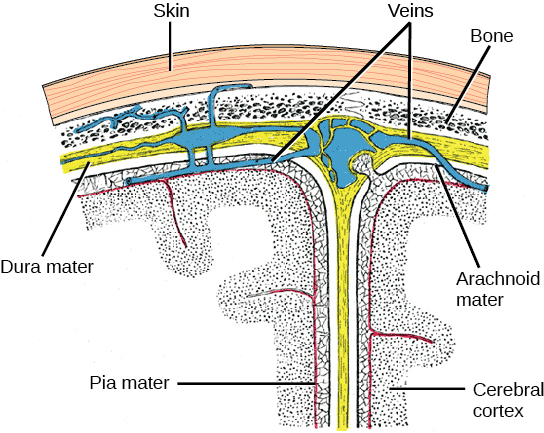The Cerebellum
The cerebellum, as the name suggests, is the "little brain." It is covered in gyri and sulci like the cerebrum, and looks like a miniature version of that part of the brain (Figure above). The cerebellum is largely responsible for comparing information from the cerebrum with sensory feedback from the periphery through the spinal cord. So it is responsible for coordinating the movements of the body and it accounts for about 10 percent of the brain.
Descending fibers from the cerebrum have branches that connect to neurons in the pons. Those neurons project into the cerebellum, providing a copy of motor commands sent to the spinal cord. If the primary motor cortex of the frontal lobe sends a command down to the spinal cord to initiate walking, a copy of that instruction is sent to the cerebellum. Sensory feedback from the muscles and joints, proprioceptive (position in space) information about the movements of walking, and sensations of balance are sent to the cerebellum, which will compare them. If walking is not coordinated, perhaps because the ground is uneven or a strong wind is blowing, then the cerebellum sends out a corrective command to compensate for the difference between the original cortical command and the sensory feedback. The output of the cerebellum is into the midbrain, which then sends a descending input to the spinal cord to correct the messages going to skeletal muscles for the coordination and balance needed.
Meninges
The outer surface of the CNS is covered by a series of membranes composed of dense, irregular connective tissue called the meninges, which protect the brain. The dura mater is a thick fibrous layer and a strong protective sheath over the entire brain and spinal cord. The dura mater has two fibrous layers (meningeal layer and the periosteal layer) enclosing dural sinuses, which carry blood from the brain to the internal jugular veins. (Sinuses are thinner-walled veins.) Three extensions of the dura mater separate parts of the brain. The falx cerebri, dives into longitudinal fissure to separate and stabilize cerebral hemispheres and keep them from colliding. The tentorium cerebelli is another fold of dura mater in the transverse fissure. It protects the cerebellum from the weight of the occipital lobes. The tentorium contours to the shape of the cerebri, and has the appearance of a 'tent' over the cerebellum. The falx cerebelli is a smaller portion of dura mater that separates the cerebellar hemispheres.

Figure 14. The cerebral cortex is covered by three layers of meninges: the dura, arachnoid, and pia maters. The yellow represents the dura that also surrounds the veins or dura sinus (blue). The arachnoid mater has a web-like appearance to it and extensions (granulations/arachnoid villi) that allow the cerebrospinal fluid to drain into the sinus (blue) and be added back to the blood stream. The thin pia mater (pink) lines the outside of the cerebral cortex like an onion skin.
The second meninx is the arachnoid mater, getting its name from the web-like extensions that go into the subarachnoid space. There is a thin subdural space between the dura mater and arachnoid mater that holds interstitial fluid. If you've heard of a subdural hematoma, it is an accumulation of blood outside of the brain in this space. However, the increase of pressure on the brain due to the increased blood causes symptoms to arise.
The outer surface of the brain and spinal cord is covered in the thin fibrous membrane of the pia mater. It is thought to have a continuous layer of cells providing a fluid-impermeable membrane. The pia mater extends across all gyri and into all sulci of the brain and cerebellar cortices. Because the spinal cord does not extend through the lower lumbar region of the vertebral column (find where it stops in the lumbar region on models and pictures), a needle can be inserted through the dura and arachnoid layers to withdraw CSF. This procedure is called a lumbar puncture.



